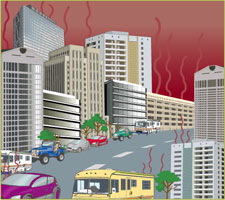Heat-Island Mitigation: Technologies for Reducing Air Conditioning Loads by Using Building Envelope Systems
 @
@ @
@
@Technologies to Reduce Sensible Heat Dissipated from Air Cooling Outdoor Units targeted by the ETV Project (hereinafter called gHeat-Island Mitigation Technologiesh) are technologies to mitigate heat island phenomena by reducing sensible heat dissipated from the air cooling outdoor units of air conditioners installed in many buildings. These technologies enhance cooling effects by utilizing latent heat absorbed when water evaporates, resulting in reduction of sensible heat dissipated from the outdoor units. Water is sprayed to the outdoor units, or cooled air is injected into them, depending on the type of equipment. These technologies are applicable to not only electric air conditioners but other air cooling outdoor units having a similar structure, such as gas heat pump air conditioners.
Technologies to Reduce Sensible Heat Dissipated from Air Cooling Outdoor Units
- Heat-Island phenomena are phenomena where the ambient temperature of the central area of a city becomes locally high (island-shaped temperature distribution). They are mainly caused by [1] increase of artificial heat exhausted from human activities such as air conditioning systems, electric apparatuses, and automobiles, and [2] increase of artificial coverings over the ground by decrease of green areas and water surfaces and by increase of buildings and pavements. The phenomena have come to gather attention recently as an environmental problem specific to cities.
- Since heat island phenomena are deeply linked with every aspects of urbanization which has progressed for a long period of time, measures against them must be considered from a long-term perspective. Therefore, it is necessary to start with measures that are feasible now. The Heat Island Mitigation Relevant Ministries Liaison Meeting was established by the national government in September 2002, and the gOutline of the Countermeasures against Heat Island Phenomena" was laid down in March 2004 which defined basic policies on measures against heat island phenomena and specific measures to be taken. These measures are now being implemented industriously. Ministry of the Environment estimates that, among heat (sensible heat to the air) having an effect on temperature rise in Tokyo's 23 wards, heat caused by artificial exhaust heat occupies about 50%, and half of the artificial heat is generated from buildings (air conditioner, etc.). Since air conditioning systems with an air cooling outdoor unit are installed in many buildings, a large number of units are being used. Therefore, effects of heat island mitigation by technologies to reduce sensible heat dissipated from air cooling outdoor units are considered to be relatively great.